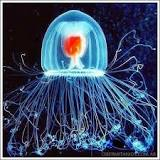Who wants to live forever?
 Living forever seems like a dream come true for humans and is thought to be something from legends, myths or science fiction. Not for the Turritopsis nutricula, also known as the immortal jellyfish. The immortal jellyfish grows to about 5 mm in diameter and has an equally high and bell-shaped figure. The walls are uniformly thin and has a bright red stomach. The young have only 8 tentacles along the edge, while the adults have 80-90 tentacles (Ma, 2010). It is truly a one-of-a-kind animal that can live forever. Its distributed all over the world’s oceans and it is suspected that the jellyfish is sometimes sucked into and pumped out of ships ballast water which is used to stabilise the ship or are attached to the hulls of ships (Than, 2009).
Living forever seems like a dream come true for humans and is thought to be something from legends, myths or science fiction. Not for the Turritopsis nutricula, also known as the immortal jellyfish. The immortal jellyfish grows to about 5 mm in diameter and has an equally high and bell-shaped figure. The walls are uniformly thin and has a bright red stomach. The young have only 8 tentacles along the edge, while the adults have 80-90 tentacles (Ma, 2010). It is truly a one-of-a-kind animal that can live forever. Its distributed all over the world’s oceans and it is suspected that the jellyfish is sometimes sucked into and pumped out of ships ballast water which is used to stabilise the ship or are attached to the hulls of ships (Than, 2009).
This is an interesting aspect of behaviour in animals of its reproduction and lifecycle as it is the only one known to man and there is not much known about it. What is known is the process by which the jellyfish “lives forever”. When the jellyfish has matured, it has the ability to transform itself back to its polyp or baby state through a process called transdifferentiation (Ma, 2010). In this process, the old cells of the jellyfish are turned into new cells and the jellyfish becomes a polyp again (Ma, 2010).
Because this jellyfish can live forever, it has caused some issues to arise. One of which is that the over-population in the ocean of jellyfish (Than, 2009). If these jellyfish continue to reproduce and live forever, their numbers will definitely continue to grow. This goes largely unnoticed due to the small size of the jellyfish and because little is known about them. The ocean eco-systems could be affected.
These mysterious creatures hold secrets we have yet to find out and could hold the secret of immortality. Scientist are conducting research and finding out more about the jellyfish. Some of the possible findings could help in the development in the medical field (Ma, 2010)
Literature Cited
Ma, H. Y. (2010). Turritopsis nutricula. Nature and science, 15-20.
Than, K. (2009, January 29). National Geographic news. Retrieved from National geographic: http://news.nationalgeographic.com/news/2009/01/090130-immortal-jellyfish-swarm.html